Anti-aircraft complex Phalanx CIWS against kamikaze boats
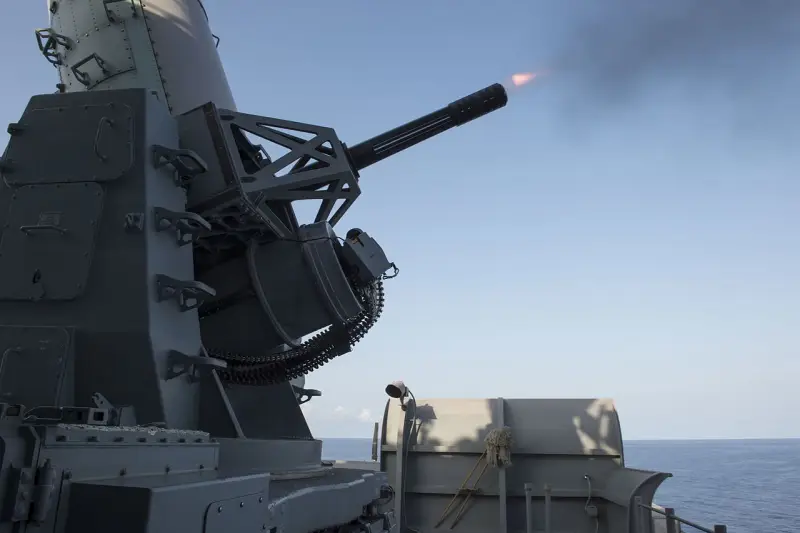
ZAK Phalanx CIWS fires
While conducting missions in the Middle East, the US Navy is again faced with the threat of kamikaze boats, manned or unmanned. Such equipment poses a significant threat to surface ships and vessels, and appropriate measures must be taken. As a simple, ready-to-use and effective means of protection against surface boats, it is proposed to use standard ship artillery systems Mk 15 Phalanx CIWS.
Decades in service
The development of the future product Phalanx CIWS (Close-In Weapon System) has been carried out by General Dynamics since the late sixties. At the beginning of the next decade, an experimental anti-aircraft artillery system was taken to the test site, and in 1973 it was installed on a carrier ship. At this stage, the main advantages of the product were shown, but at the same time, the disadvantages appeared. It took the next few years to correct them.
At the end of the seventies, the ZAK "Falenks" successfully passed all tests and entered production. In 1980, the first ship received a full set of such products, and after that the number of their carriers constantly grew. Currently, US Navy warships of almost all current types are equipped with Mk 15 complexes in varying quantities. In addition, ZAKs were supplied abroad for installation on foreign-built hulls.
Since the early eighties, US Navy ships have repeatedly participated in various operations and used their Phalanx CIWS systems. These ZAKs have several air and surface targets of different classes in combat. At the same time, during combat use there were some unpleasant incidents. So, there were random shots with consequences, friendly fire, etc.
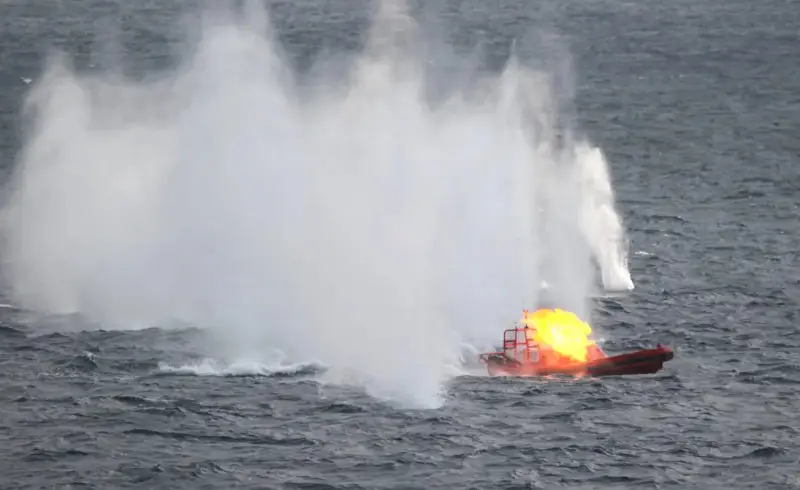
Shooting at a target boat
The specialized organizations of the Navy are studying the possibility of new threats and ways to combat them. Thus, in recent years, the potential of unmanned surface ships with weapons or warheads has been actively studied, and the search for effective countermeasures has been carried out. During the relevant tests and studies, the Phalanx CIWS ZAK showed the best results - it was able to detect surface targets in a timely manner and hit them with high accuracy.
Since October 2023, the US Navy ship group has been operating in the Red Sea and protecting shipping from attacks by the Yemeni Ansar Allah movement. The Houthis are trying to interfere with sea communications using their existing anti-ship missiles and kamikaze boats. At the same time, the American fleet gets the opportunity to test the theoretical developments of the recent past.
Technical part
The Phalanx CIWS product is an automated artillery mount designed to combat air and surface targets in the near zone. It was created as the last echelon of the ship's defense in case the threat breaks through other means of defense. The ZAK was required to react quickly and be able to quickly inflict maximum damage on a target - these requirements determined the main features of the appearance.
The Felenks complex is designed as a combat module with a height of 4,7 m and a weight of up to 6,3 tons (for later modifications), which has all the necessary devices and systems. The module has a rectangular box-shaped base on which a rotating device with a swinging part is placed. The latter is equipped with an automatic cannon and radars in a characteristic casing, giving the entire complex a recognizable appearance.
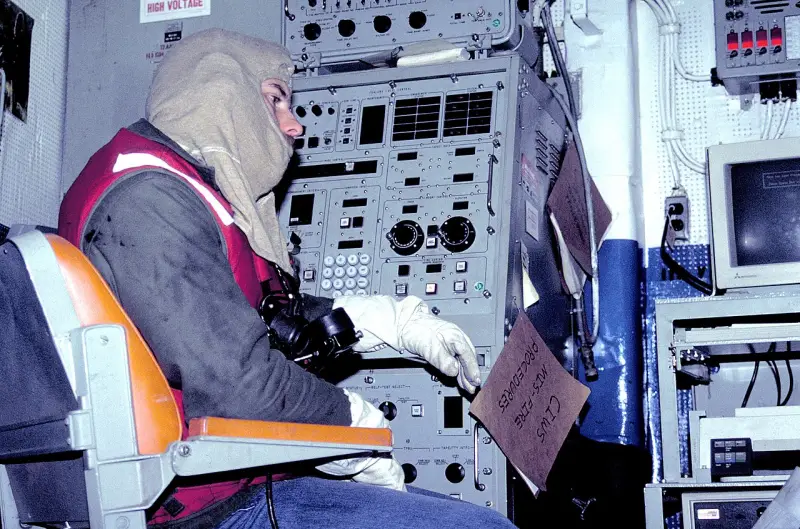
"Falenx" operator at work
The ZAK is equipped with a six-barreled 20 mm M61 Vulcan cannon with external drive. Early modifications of the complex used a gun with a barrel length of 76 klb; in the later ones they introduced a gun with barrels 99 klb long. External drive and automation provide a rate of fire of 3-4,5 thousand rounds/min. The design of the installation provides horizontal guidance within 150° to the right and left of the neutral position and vertical guidance from -25° to +85°.
For firing at air targets, the Mk 244 round with an armor-piercing projectile of “increased lethality” is used. Such a projectile should be capable of damaging the penetrating warhead of an incoming missile and causing it to explode. High-explosive incendiary shells are used to target coastal targets. The ZAK's ammunition capacity is 1550 rounds in a special magazine.
The complex is equipped with two radars located in a common casing. Under the top cap there is a rotating antenna of the detection station, which is responsible for illuminating the situation and identifying dangerous objects. Phalanx CIWS does not have a friend or foe identification system, but the detection radar can assess the course and degree of danger of an air target. Detection range is at least 8-10 km.
An object flying towards the ship is automatically transferred to the tracking and fire control station. Such a radar with a fixed antenna continues to monitor the target and provides data for firing. In addition, it accompanies fired shells and adjusts fire. Depending on the target parameters, tracking begins from ranges of at least 3-5 km. The fire opens at 2 km or closer.
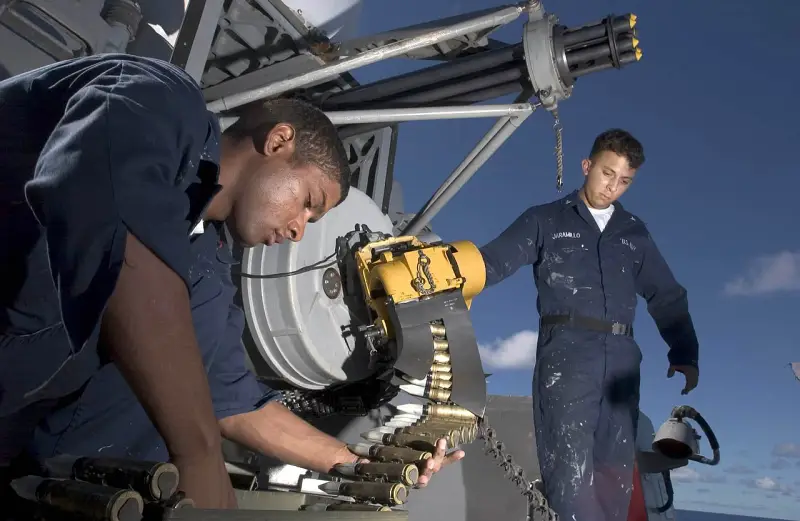
Store loading process
The complex is controlled from a remote control at the central post of the carrier ship. The operator has the ability to control all operating parameters and receives data from the radar. He can select the operating mode of the complex and target destruction - automated with human participation or fully automatic.
Gun vs boat
As part of the current US Navy operation in the Red Sea, Phalanx CIWS systems are used for their intended purpose - to intercept incoming missiles. The first victory of this kind was reported at the end of January. In addition, high-speed kamikaze boats are a typical threat in the current conditions. The standard air defense systems of American ships can work against such targets and demonstrate sufficient effectiveness.
Several key factors contribute to achieving acceptable results. First of all, you need to consider the features of the new goal. A surface boat is a small or medium-sized target with a high (by surface fleet) speed. In terms of size and difficulty of detection/tracking, it is similar to anti-ship missiles, which are typical targets of the Felenx. At the same time, the speed of the boat is several times lower than that of a rocket. This makes him an easier target to escort and destroy.
During tests in the recent past, the standard radars of the Mk 15 complex showed their ability to detect boats and motor boats over the entire range of operating ranges. They also provide sufficient fire accuracy. Apparently, this is due to the existing stock of characteristics - the boat is much slower than a typical air target.
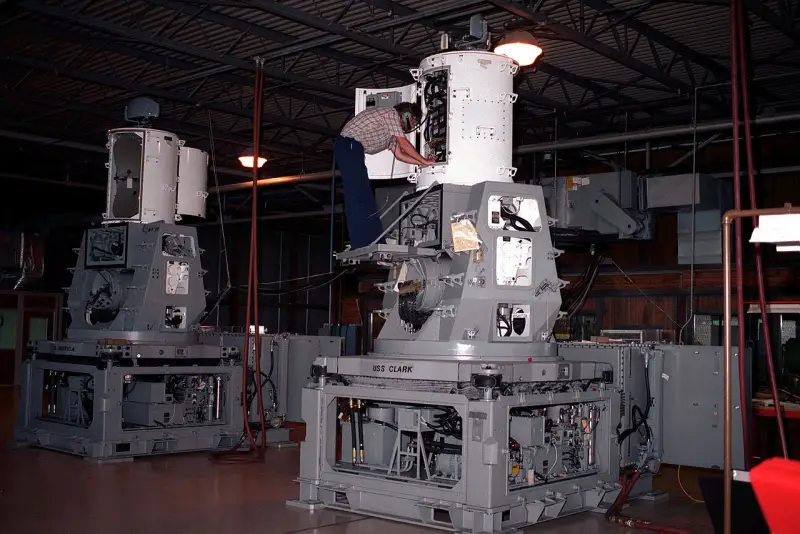
ZAK without casings. Radio systems are clearly visible
The firing characteristics of the M61 cannon are also more than sufficient to guarantee the destruction of a surface object at a limited speed. The main factor of this kind is the rate of fire - it increases the likelihood of numerous hits and causing sufficient damage to the boat. In this case, it is possible to destroy the warhead and detonate the target at a safe distance. This effect can be achieved using any projectile used, both armor-piercing and fragmentation.
The design of the complex also matters. The Phalanx CIWS module is capable of firing at fairly large declination angles. This makes it easier to fire at surface targets from the high side of the carrier ship. In addition, the dead zone near the ship is reduced and the available firing time is increased.
It is also necessary to note the economic features of Felenx. Thus, one unitary 20x102 mm shot for the M61 cannon costs just over $45. The full ammunition load of the complex costs the taxpayer almost $70 thousand. Moreover, the ammunition allows you to hit several targets sequentially. In terms of combat costs, the ZAK is superior to any missile system capable of attacking surface targets.
Remedies
The capabilities of the Phalanx CIWS to combat small surface targets were determined during recent tests, and now the US Navy can test them in practice. We can expect that small-caliber artillery installations will show good results and will help in the fight against a new characteristic threat.
It should be noted that not only the American Felenx can solve such problems. Foreign developments in the field of naval anti-aircraft artillery, incl. Russian. With proper organization of combat work and joint use with other weapons, they can become a convenient and effective means of protection against a new type of threat.
Information